January has been a woody month a month of trees 1300 trees have been planted
It began on January 1st with 800 willows. To plant willows you just poke a hole of the same diameter as the willow cutting into the ground and push the 30cm stick in half way up its length. 700 of these willows are Viminalis Riefenweide a recent fast growing hybrid; suited to high costal winds and can be used as a windbreak and for fuel. This has been positioned between the pond and fruit tree area as a solid block offering further wind protection to the fruit trees and helping to drain the low wet clay area of the land. Willows are hungry trees so they will be fed with the compost toilet and a gap is kept between the block of willows and other trees. Next year the entire block will be harvested then they shall be on a 4-year rotation providing heating fuel. 100 of the willows are Dicks, Darks, and Light, Lancashire and Green these are all basketry willows, which will be harvested each autumn for baskets and rustic stuff
We have planted a coppice. 20 Ash, which are separate from the main coppice wood as they are reputed to have a negative allopathic effect on other trees. I have put 2 Lime trees in the group of Ash they coppice and provide minerals to the surrounding soil I will observe if they survive the Ash negative effect hopefully they will as they are there to do the Ash good
Alongside this coppice is a 60 tree mixed coppice Hazel in the darkest area surrounded by Alder Glutinosa a nitrogen fixer which does coppice and False Acacia/Black Locust another nitrogen fixer and mineral accumulator which produces a pea which is good for chicken feed it is also good construction timber. The coppice trees are spaced 1meter apart to encourage tall straight growth as they compete for light
The shelterbelt along the South and West boundary is 300 alders; Cordata on the higher dry ground and Glutinosa and Ruba on the lower ground. These are fast growing nitrogen fixing trees capable of withstanding high winds; They grow to around 15 meters and give wind protection for 10 times the height in distance so when fully grown it will be a wind fee zone 100 m from the shelter belt which is well past us our land. The northern edge has a line of sea buckthorn another nitrogen fixer, which is good in costal winds it provides a citrus fruit and is very thorny so we are using it along the public road as a security fence. 2 neighbouring houses protect the Northeastern edge from wind and trees already line the eastern boundary
We have also planted out the exciting fruit and nut trees. Anglesey has culled the grey squirrel so we are hoping for a substansional nut crop planting Hazel, Almond and Chestnut. We have Apples, Pears, Damsons and Plum from a local supplier who has specialised in discovering and saving rare Welsh varieties of fruit trees. In amongst these trees are nitrogen fixing mineral accumulators which fruit and have edible leaves and further fruit trees. Most of the fruiting trees are not self fertile so at least 2 varieties have been planted
For the lower layer planted in amongst the trees are gooseberries, blackcurrants, and raspberries. Also I have some blueberries for a particularly acid patch of land that I hope to work to advantage. I will put a full list of plants in the Forest Garden section of the site
With all these tart fruits I was worried about the amount of sugar I would need so was looking around for Stevia plants which I used to pick up on the market in France. Discovering they are illegal in most of Europe and Northern America due to Tate and Lyle arguments against the producers. As it is used widely in Japan and Southern America I was able to buy seeds from ebay; An unmarked Jiffy bag of illegal seed heads arrived successfully from Paraguay and I am attempting to start those in the green house T&L sniffer dogs should not be able to smell these from the road
I have also many seeds for the forest floor with herbs, bee attractors and useful flowers alongside more normal food seeds from Garden Organics and Heritage Seed Library. These have been organised into planting times around the Luna cycle with leafy plants planted during a waxing moon and root plants during a waning moon I have done this as a way of organising the plant diary for the next few months and my fridge is rather full of jam jars of sand and seeds
Many of the seeds are conventional and will go into the annual beds this has been fenced and I have planted a mixed hedgerow around the fence of Sloes, Hazel, Crab Apple, Wild Rose, Dogwood, Lime and Alder these should all layer and grow into a nice low hedge to offer further wind protection and encourage beneficial insects and provide food
Normally I would mulch with a thick layer of cardboard and straw but I do not have enough cardboard for everything. Therefore the oat paddock, coppice, willows and windbreak are being mulched with just a thick layer of straw and hopefully this will be enough to keep the competing grass down.
The straw comes from a farm very close by these are huge bails about 20 times the conventional size we get 2 onto the trailer then we have devised a cunning plan for getting them out of the back of the trailer when they were out we noticed the chickens quite like the straw so we distributed piles of straw to the areas we wanted mulch and left it to the chickens to spread and check for seed heads its nice to see them earning their chicken treats
The tractor shed is beginning its transformation into a workshop circa 1925 with the collection of period machinery and engines, which will be used later in the project.
We are rounding up January by trying to finish work on the land and workshop for now and begin the building preparations. Our planning permission has finally come through and we have had a first meeting with the building inspector to plan progress so this should be the main focus of February

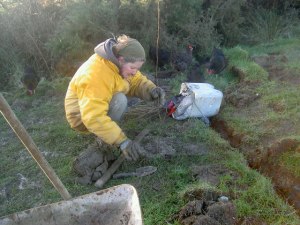

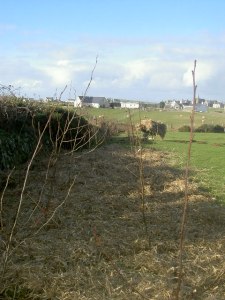
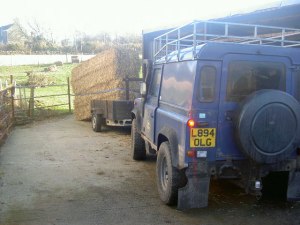
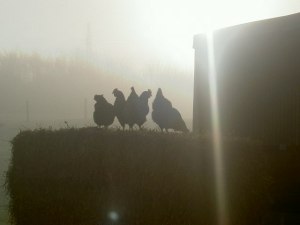
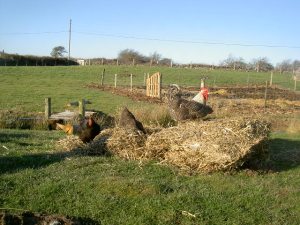

Hi, this is a comment.
To delete a comment, just log in, and view the posts’ comments, there you will have the option to edit or delete them.
Hi Sue, hi Ted,
we visited your website and watched the film. Very nice pigs. I tryed to find your home on google maps – without success. Is it near the A5025, Lon Las? We are fine. Please send me again your phonenumber.
Greetings from Germany
Dieter & family